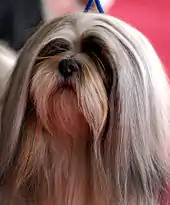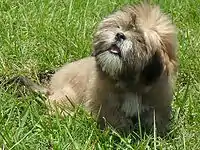Lhasa Apso
The Lhasa Apso (/ˈlɑːsə ˈæpsoʊ/ LAH-sə AP-soh) is a non-sporting dog breed originating in Tibet.[1] It was used as an indoor sentinel.
| Lhasa Apso | |||||||||||||||||||||||||||||
|---|---|---|---|---|---|---|---|---|---|---|---|---|---|---|---|---|---|---|---|---|---|---|---|---|---|---|---|---|---|
 | |||||||||||||||||||||||||||||
| Origin | Tibet (China) | ||||||||||||||||||||||||||||
| |||||||||||||||||||||||||||||
| |||||||||||||||||||||||||||||
| Dog (domestic dog) | |||||||||||||||||||||||||||||
Lhasa is the capital city of Tibet, and apso is a word from the Tibetan language. There is some debate over the exact origin of the name; some claim that the word "apso" is an anglicized form of the Tibetan word for goatee ("ag-tshom", ཨག་ཚོམ་) or perhaps "ra-pho" (ར་ཕོ་) meaning "billy goat".[2][3] It may also be a compound noun meaning "bark-guard" (lit. "ap" [འབ་], to bark, and "so" [སོ་], to guard).[4][5]
Appearance




Male Lhasa Apsos should ideally be 10.75 inches (27.3 cm) at the withers and weigh about 14 to 18 pounds (6.4 to 8.2 kg). The females are slightly smaller and weigh between 12 to 14 pounds (5.4 to 6.4 kg). The breed standard requires dark brown eyes and a black nose, although liver-colored Lhasas have a brown nose. The texture of the coat is heavy, straight, hard, neither woolly nor silky, and dense. They come in a wide variety of colors including black, white, red, and gold with various shadings. Lhasas can be with or without dark tips at the ends of ears and beard. The tail should be carried well over the dog's back. The breed standard currently used by the American Kennel Club was approved on July 11, 1978.[6]
Temperament
Lhasa Apsos are independent as well as very loyal and eager-to-please dogs, yet they may be suspicious toward strangers.[7] This dog ranks 68th (out of 79) in Stanley Coren's The Intelligence of Dogs, being of fair working-obedience intelligence.[8][9] The Lhasa Apso is a long-lived breed, with many living in good health into their early 20s.[10]
History

The Lhasa Apso originated in Tibet. This small breed was used as a sentinel dog indoors while the larger Tibetan Mastiff remained outside.[11] In the early 1900s, a few of the breed were brought by military men returning from the Indian subcontinent to England, where the breed was referred to as the "Lhasa Terrier".[12]
The original American pair of Lhasas was a gift from Thubten Gyatso, 13th Dalai Lama to C. Suydam Cutting, arriving in the United States in 1933. Mr. Cutting had traveled in Tibet and met the Dalai Lama there.[13] At this time, there was only one Lhasa Apso registered in England.[14] The breed was at first called the Lhasa Terrier, later the Lhasa Apso. The American Kennel Club officially accepted the breed in 1935 in the Terrier Group, and in 1959 transferred the breed to the Non-Sporting Group.[15] In the UK, they are placed in the Utility Group.
Certain characteristics which are part of the breed type evolved as a result of the geographical and climatic environment — the high altitudes, the dry windy climate, the dusty terrain, the short hot summer, and the long bitterly cold winter of the Himalaya region. Among these are head features, the coat, eye-fall, the musculation and body structure, the general hardiness, and longevity of the breed.[16]
Today, in the US, there exists a unique group of Lhasa Apsos known within the fancy as the Gompa dogs. (Gompa is the Tibetan word for a monastery's main meditation hall.) These Lhasa Apsos are direct descendants of the Lhasa Apsos from the Drepung monastery in Tibet, where, in 1941, Lama Gyen Yeshe was gifted Preserving the Future, Enlisting the Past his first Lhasa Apso by a High Reincarnate Lama. In the 1980s, nine Lhasa Apsos bred by the late Lama Gyen Yeshe or sired by one of his dogs were brought into Canada. Bred together for a number of years, descendants were eventually registered with the United Kennel Club (UKC). In 2000, the remaining descendants entered the United States as part of a successful rescue. Since then, organized efforts have been made to maintain the dogs and preserve the line. The Gompa Lhasa Apso Preservation Program (GLAPP), a 501(c)3 organization, is a small population genetics management program perpetuating the genetic lineage of the Gompa Lhasa Apso. Not having undergone selection to a written standard, this unique gene pool represents the Lhasa Apso as it developed as a landrace. GLAPP's internal database contains records of all dogs being used to perpetuate this genetic lineage and includes DNA Profiling, DNA Parentage Verification, and microchip identification. Dogs born within the Preservation Program continue to be registered with UKC.[17] In August 2011, seventeen dogs from the Gompa Lhasa Apso Preservation Program entered the American Kennel Club (AKC) studbook. The goal of recording recently imported region-of-origin Lhasa Apsos is to increase genetic diversity while maintaining the integrity of the AKC studbook.[18]
Shedding

Like most mammals, all dogs slough off dander, or flake dead skin. Since dander and many other allergens become trapped in hair, the susceptibility of allergies acting up is dependent on the amount of hair shed and the weight of the hair. As the amount of hair shed increases and the weight of the hair decreases, the probability of airborne hair, dander, and allergens increases. This will, therefore, increase one's allergies to a particular animal. Lhasas have long coarse hair which causes the weight of the hair to be heavy. Due to the long length of hair, Lhasa Apsos do not shed hair the same way as other breeds. Instead, they shed hair like humans, slowly and continuously, as to keep their hygiene clean and risk of matting and tangling low. The long, heavy hair prevents individual hair strands to become airborne and decreases the amount of dander in the air as compared to other breeds. People with allergies may co-exist with the low-shedding breeds of dogs like the Lhasa Apso.
Coming from the extremely cold weather of the Himalayas, the Lhasa has a double coat: an undercoat to keep them warm and an outer coat consisting of guard hairs for protection and aiding to keep their coat flat and smooth. The outer coat consisting of the guard hair should be similar to human hair; one should be able to feel individual hair strands when touched. While the undercoat is softer and finer, it should lie flat and blend with the outer coat.
Routine brushing and bathing are necessary, not only to keep up on the slow continuous shedding but also to remove any dirt and debris that may get caught within the hair strands. A Lhasa with a thick, coarse outer coat will likely require less grooming than a Lhasa with a lot of undercoats and soft, less coarse top coat.
Health

The Lhasa Apso is prone to a few health problems but is still a very healthy breed. For example, it is susceptible to sebaceous adenitis, a hereditary skin disease that occurs primarily in Standard Poodles but has also been reported in a number of other breeds, including the Lhasa Apso. They are also prone to the genetic disease progressive retinal atrophy (PRA) which can render them blind. Responsible breeders have their breeding dogs checked yearly by a canine ophthalmologist to check that they are not developing the disease, which is heritable in offspring. Lhasa Apsos are also prone to eye diseases, such as cherry eye and keratoconjunctivitis sicca (KCS or dry eye syndrome).[19] A 2004 Kennel Club survey puts the median lifespan of the breed at 14 years 4 months.[20] UK vet clinic data puts the median at 13.0 years.[21]
While regarded by many as a "lap dog", Lhasa Apsos do require daily exercise, by play and walks, to maintain physical health and mental well-being.[22]
In popular culture
- In the animated series Spider-Man and his Amazing Friends, Angelica Jones/Firestar owns a Lhasa Apso named Ms. Lion.
- In the television series The L Word, Helena is assured by her wealthy mother that she was going to leave her inheritance to her, not to her Lhasa Apsos.
- Homer Simpson has a Lhasa Apso in the episode "Three Gays in a Condo".
- Lhasa Apsos are said to bring luck, hence the saying "Lucky Lhasa".[23]
- Actress/singer-songwriter Keke Palmer has a Lhasa Apso named Rust.[24]
- Peg in the 2019 remake of Lady and the Tramp is a Lhasa Apso. In the original film, she was a Pekingese.
- A Lhasa Apso is both a major character and a plot device in the 1948 children's novel Daughter of the Mountains by Louise Rankin.
- In the Flash animation series Princess, a Lhasa Apso plays the titular character.
- Gospel artist Gerald Wolfe has a Lhasa Apso named Wookie.
- Presenter Lucrezia Millarini has a Lhasa Apso named Milo.
References
- Definition of Lhasa apso, EtymologyOnline.com
- Wehrmann, Stephen (2002). Lhasa Apsos: Everything about Purchase, Care, Nutrition, Behavior, and Training. Barron's Educational Series. ISBN 0-7641-1958-3.
- Wiktionary
- Definition of "ab-pa", Rangjung Yeshe Tibetan Dictionary
- Definition of "so-ba", Rangjung Yeshe Tibetan Dictionary
- Club, American Kennel. "Lhasa Apso Dog Breed Information". Retrieved 27 July 2016.
- "Lhasa Apso Temperament – What's Good About 'Em, What's Bad About 'Em". Your Purebred Puppy. Retrieved January 8, 2013.
- "Dog intelligence rankings". 6abc.com. WPVI-TV. November 12, 2008. Retrieved June 16, 2012.
- "Ranking of Dogs for Obedience/Working Intelligence by Breed". Archived from the original on June 2, 2019. Retrieved January 13, 2016.
- "Border Collie, Chinese Crested, English Mastiff, Italian Greyhound, Lhasa Apso". Dogs 101. Season 2. Episode 5. October 31, 2009. Event occurs at 3:01. Animal Planet. Retrieved January 27, 2013.
- Medical, Genetic & Behavioral Risk Factors of Lhasa Apsos, Ross D. Clarke, Xlibris 2014 p1.
- Rogers Clark, Anne; Andrew H. Brace (1995). The International Encyclopedia of Dogs. Howell Book House. p. 294. ISBN 0-87605-624-9.
- Wehrmann, Stephen (2002). Lhasa Apsos. Barrons Educational Service Publisher. ISBN 0-7641-1958-3.
- Aldige, Leslie (22 July 1968), "Dog of the Year", New York, pp. 32–34
- "Lhasa Apso History", American Kennel Club
- Sefton, Frances. Lhasa Apso Breed Type
- "Preserving the Future, Enlisting the Past" (PDF). Archived from the original (PDF) on June 13, 2017. Retrieved February 9, 2016.
- "Native Stock Committee - ALAC". lhasaapso.org. Retrieved 2016-02-09.
- Lhasa Apso Health at dog-breeds.in
- "Individual Breed Results for Purebred Dog Health Survey". Retrieved 26 June 2012.
- O’Neill, D. G.; Church, D. B.; McGreevy, P. D.; Thomson, P. C.; Brodbelt, D. C. (2013). "Longevity and mortality of owned dogs in England" (PDF). The Veterinary Journal. 198 (3): 638–43. doi:10.1016/j.tvjl.2013.09.020. PMID 24206631.
- "Lhasa Apso". dogbreedinfo.com. Retrieved 2016-07-27.
- Bailey, Mrs. Eric. Origins of the Lhasa Apso Archived 2011-12-03 at the Wayback Machine
- MTV Cribs